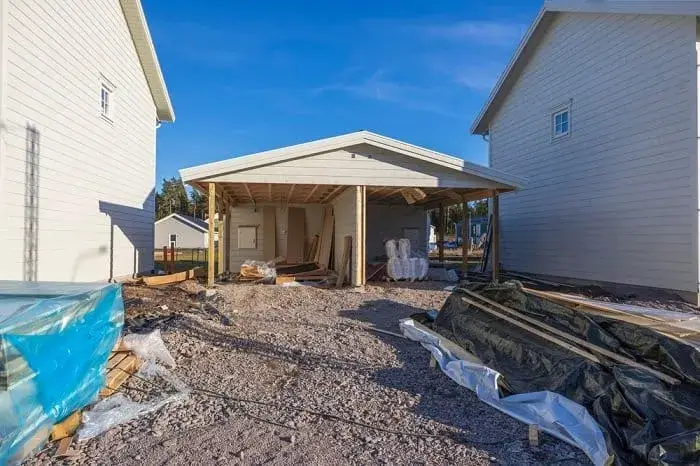Last Updated on August 5, 2023 By Emma W. Thomas
There is no standard limit since setbacks vary in different states and counties, but generally, it could be 10 feet on the front, 4 feet on the sides, and 10 feet on the rear. It also differs depending on the nature of the structure to be protected.
How Close To The Property Line Can I Build A House?
- Zoning Regulations:
Zoning regulations imposed by local authorities determine the minimum distance required between the house and property lines. These guidelines are established to maintain privacy, prevent fire hazards or spread, ensure access to utilities, and preserve the character of the neighborhood. - Setback Requirements:
The term “setback” refers to the minimum distance a house must be set back from the property line. Setback requirements vary depending on the zone or district in which the property is located. Zoning codes typically classify different zones into residential, commercial, or mixed-use categories, each with its own setback regulations. - Residential Setback Guidelines:
In residential areas, setback requirements are usually more stringent to maintain neighborhood aesthetics and ensure adequate space between structures. Depending on the local regulations, setbacks may range from 5 to 25 feet for front yards and 3 to 10 feet for side and rear yards. - Corner Lots:
If your property is situated on a corner, it is subject to additional setback regulations. This usually means greater distances from both street-facing sides of the property to maintain visibility for drivers and pedestrians. - Easements:
Easements refer to specific areas on a property that are designated for access by utility companies, such as water lines, gas pipes, or electrical cables. These areas generally have their own setback requirements to allow for easy maintenance and future repairs. - Variances and Exceptions:
In certain cases, property owners may seek variances or exceptions to setback regulations. This requires presenting a compelling case to the local authorities, accompanied by detailed plans and justifications. However, obtaining a variance is often challenging and not guaranteed. - Encroachment Consequences:
Failure to comply with setback regulations may result in legal consequences, including being forced to rebuild or modify the structure, fines, or legal action by affected neighbors.
Ways Of Knowing Your Property Line

There are many ways that you can use to know where your land starts and ends among them;
Looking At The Deed
You can consult the documents that relate to the purchase of your property, such as the deed. A deed is a document that explains the property in question. It also specifies the extent to which the land stretches.
Consult A Surveyor
If you find the survey report hard to understand, you can get a surveyor to mark it out for you. This professional will provide a plat map that shows the report of the survey they carried out. In this plat map, the survey outlines the property lines or boundary lines of your land.
Look For Permanent Markers
Your land ought to have permanent markers placed on it. The marker is usually a metal bar buried underground, and you can find it without the help of a surveyor. You can easily locate the bar using a metal detector that senses the presence of metal in the ground.
Rules Applicable To The Property Line
The rules that apply to the property line vary according to zones. They also depend on the public property or facility to be protected by the boundary. The facilities to be secured include roads, rivers, highways, septic tanks, and railway lines. Before you purchase a piece of land, it is necessary to understand the rules to avoid violating them.
It is important to understand the zoning codes that apply in your area before erecting a structure. Some rules prohibit building on property lines, while others specify the limits for structures such as fences. You can also be required to get permits for buildings exceeding certain limits.
Property line rules keep changing, and it is, therefore, necessary to know what applies at a particular time. These rules apply to new buildings but not the existing ones. However, if you intend to add extensions or reconfigure your property, the setback requirement will apply.
What Are The Penalties For Violating Property Line Rules?
Violating the property line rules attracts both criminal and civil penalties that can incur additional costs. Anyone who may suffer as a result of such violations will be entitled to compensation. If the building is already complete, it might be difficult to pull it down due to the setback issues. In such a situation, the authorities award damages against a property owner who violates the setback. One is required to compensate the other party for the loss incurred from the violation.
If the violation is not severe, one is required to make adjustments to the property line to accommodate the necessary setback. Someone that violates setback rules can also receive injunctions to halt the building activities. The authorities may also order a property owner to pull down and move back structures such as fences if they violate setback requirements.
What Are The Functions Of Setbacks?
Setbacks have several purposes for a property that includes;
Creating A Safe Space Between Properties
Different properties have varying purposes and thus require a safe space. A setback protects various land uses by separating one property from another. It helps to prevent houses from being built too close to each other.
Secure The Usage Of Lands
If different land usages are not compatible, there must be adequate setback regulations put in place. The purpose of these requirements is to secure the usage of each piece of land. For example, land in which hazardous materials are produced and stored should not be close to residential quarters.
To Decongest Streets
Setbacks help to widen streets, thus dealing with the issue of congestion in densely populated towns. They help to make roads and streets wide to accommodate the high population.
Helps In Lighting And Ventilation
Setback requirements regulate the space between buildings hence enhancing lighting and ventilation. These regulations ensure that there is no obstruction between buildings and improve one’s access to their property.
How Are Setbacks Measured?
A setback is measured starting from the nearest part of a building or structure to the property line. When measuring a setback, both the front and rear sides are considered. There are, however, some minor structures on a property that authorities exempt when measuring, such as flagpoles, signs, and mailboxes. They may also exempt recreational structures such as swings and treehouses.
In denser parts of a town, setbacks are put in such a way as to allow a light angle of about 30 degrees. This allowance provides adequate ventilation and prevents overcrowding in that location. Generally, the setback for a property is 10 feet in the front, 10 feet on the rear side, and 4 feet on the sides. However, this may vary according to different zones.
As a general rule, you are not supposed to build over public utilities such as telecommunications, water, or power. But, if you must build in these areas, you need to obtain written consent from the authorities.
Who Determines Setbacks?

Zoning authorities are responsible for determining setback requirements. The local government creates building codes that specify the setbacks through zoning regulations. Zoning rules separate several land uses by dividing them into residential, industrial, and commercial areas.
The authorities also specify the restrictions in different zones, including the types of structures in a particular zone. It includes the use of land both in the present and future.
Conclusion
Setbacks and property lines are necessary and should be clearly defined when one is developing real property. You need to understand the setback requirements in your location to avoid violations that may lead to penalties.
References:
https://housegrail.com/how-close-can-you-build-to-property-line/
https://backyardscape.com/how-close-to-my-neighbors-boundary-can-i-build/
Emma is a graduate of Domestic Science or Family and Consumer Sciences (Home Economics) from the University of Wisconsin. She has 7 years of experience Working with the strategic section of BestBuy and now writing full-time for Homeeon.
From Managing the Home, Interiors, Cleaning, and Exteriors to Gardening and everything about Making A Home Liveable – is her passion and this Homeeon is the result of this.
Emma loves decorating her home with the best stuff found online. She cares about quality over anything and writes reviews about them here in Homeeon. Get in touch with her over Pinterest.
Keep reading her blogs.

